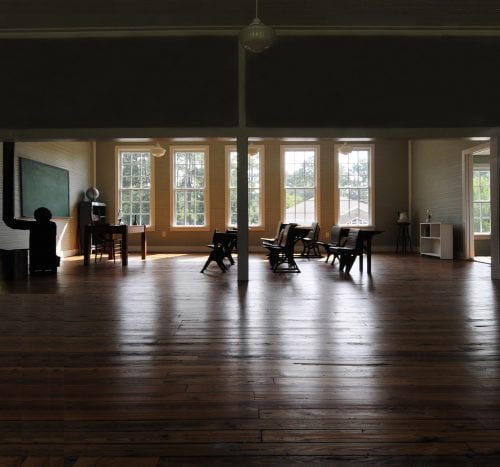
Implementing Brown v. Board of Education: One Southern Town's Story
Part I: Behind the Scenes, an Interracial Team Plans Integration
In May of 1954, the Supreme Court ruled in Brown v. Board of Education, finding segregated schools “inherently unequal.” One year later, the Court issued its “Ruling on Relief,” mandating that desegregation proceed “with all deliberate speed.” Given the deliberate vagueness of the instruction, Southern school authorities delayed compliance. As a white child born in 1954 who grew up in the small town of Belmont, North Carolina, I did not share my classroom with a single black student until I was an eleven-year-old sixth grader. Later I would inquire why it took so long.
Many white Southerners did not accept integration as unavoidable until the Civil Rights Act passed in the summer of 1964, when I was ten years old. This act required integration in employment, retail businesses and restaurants, and public facilities like libraries, parks and museums—as well as schools. Even then, many Southern school districts stalled for time, some waiting until the 1971 Supreme Court ruling in Swann v. Charlotte-Mecklinberg School District, which compelled the district serving North Carolina’s largest city to integrate despite the de facto segregation of residential neighborhoods. The plan the Court eventually endorsed unanimously for Charlotte—after much negotiation among the judges—used a combination of newly organized magnet schools and long bus rides to achieve integration.
A Human Relations Committee Forms to Plan Integration
In Belmont, a small town just west across the Catawba River from Charlotte, school integration presented fewer logistical problems, because segregated schools for black and white children were situated within a mile of each other. More proactive than many communities,[1] Belmont initiated its integration plan only two months after the 1964 Act passed. Even so, Belmont’s leaders did not publicly promote the plan. They hoped to introduce it quietly and gently to a skeptical and potentially hostile white community. They would test that community’s receptivity to African American students by sending a group of carefully vetted volunteers into formerly white schools during the 1964–1965 school year. As a fifth grader, I had no idea such plans were being made; but when I returned to school the next year, I met a new student: a very quiet, studious black girl, the daughter, I would learn, of a local pastor.
I was only dimly aware that my father served on the local “Human Relations Committee.” Initiated by black church leaders, who had invited several trusted white clergymen and business leaders to work with them, this citizens’ committee were planning the integration of Belmont’s schools and businesses. Later, when I reached high school, I talked with my father about how he’d helped to locally implement the Brown decision. He explained that the quiet black child had been deliberately placed in my sixth-grade classroom, just as two other black children had been placed in the ninth and third grades, in the classes where my older sister and younger brother sat.
Quietly Integrating Black Children into Majority-White Schools
In Belmont, integration faced three political problems. First, would white students accept black students without public protest or secret retaliation against the students themselves? On the first day of school in September 1964, when three young black women enrolled in Belmont High School, no angry outburst disrupted the order of the school day. Whether the black students felt welcomed and comfortable is another question. Still, to those orchestrating the integration process, this first year of limited integration succeeded well enough, and plans were made to send other carefully chosen black students into the elementary and junior high schools in September 1965.
I believe my sister and brother, both more extroverted than I, welcomed the new students warmly, probably helping their adjustment in a small way. I, however—then a very shy child—did not reach out to my new classmate, and the memory of my standoffish behavior still haunts me. Still, I wonder why my parents never sat me down to explain how I should behave. They probably talked about it in indirect ways, hoping I would catch on. They seemed to think integration would proceed most smoothly if the minimum attention were called to it.
Accustoming White Families to Black School Teachers
When this second year’s trial also worked, plans were finalized for the third year, when all of the black community’s school-age children would enroll in the formerly white elementary and secondary schools. But this meant also integrating the teaching staff of Reid School, which served the black community, into the formerly white schools. Might those white parents whose children drew black teachers complain? To make clear that black schoolteachers would serve in equivalent roles to those of white teachers, the Human Relations Committee proposed to school officials that teachers for the entire fourth grade class during the 1966–1967 school year be drawn from Reid School. There had been only one or two fourth grade teachers at Reid, while at Belmont Elementary School there had been four. The latter now received new and unexpected grade-level assignments, just as several black teachers were drawn out of other grades to cover the fourth. None of the teachers with shifted assignments were happy about it; but no doubt the black teachers unused to both fourth grade curriculum and to majority-white classrooms faced the greater challenge.
Whether to Save or Close a Beloved Black School

So far, so good; but the third political problem facing the integration plan seemed irresolvable: what would happen to the well-loved Reid School, which had provided both elementary and secondary education for all black students in town since visionary educator Charles Reid became principal in 1914?[2] It was a cultural center for the black community, where dedicated teachers working with the white schools’ discarded textbooks cultivated black students’ futures. But school officials felt white parents would not send their children to a school in a black neighborhood without fierce protest. They decided that Reid School would close for good. The facilities at Reid were no longer needed, they said, since Belmont had increased its classroom capacity in 1964 by opening a new high school and converting the old high school into a new middle school.
The black community would castigate this decision, especially after the old school was demolished, along with the auditorium that had housed community events, the trophy cases housing awards for Reid’s winning teams, and a brand new gymnasium that many had hoped to see converted into a town recreation center.
The White Reformer’s Perspective
I don’t think my father ever seriously questioned the decision to close Reid School. To him, Reid’s closure was just one element of a countywide school consolidation he was working to accomplish. (He’d been interested in this reform since serving a term as foreman of the Grand Jury and making it his task to investigate the wildly divergent school facilities across the county. He’d found they ranged from well maintained buildings in Belmont to, in a distant rural area, a one-room schoolhouse heated by a pot-bellied stove.) He hoped to see racial integration occur throughout the county as part of the student reassignments that would result from consolidation and new building.
Pleased to see the school system modernized and countywide racial integration quietly begun, did Dad stop to consider the loss borne by black students and teachers as they left the more supportive environment of the older black schools? I’d like to think he did; but I don’t know that he dwelt on it. He wanted to see the integration of schools and businesses in Belmont. He wanted to help make the “New South” a more just, more prosperous place. An optimist, he saw racism as thoughtless conformity to an irrational code. To change the code, you just had to signal to the white community that new and better behavior was now expected. Years later, recalling visits to local restaurant owners whom he asked to serve black customers, he told me, “You’d be surprised how many people were willing to do it if you just asked.”

[1] But not as proactive as some. In my father’s papers I found a pamphlet published by the Southern Regional Council, “Next Steps in the South: Answers to Current Questions.” It states that prior to the Brown decision, segregation was required by law in 17 states and the District of Columbia. But “two years after the decision, more than 350 school districts in nine of the 17 states had desegregated their public schools. Schools in the nation’s capital were also opened to all” (Reprint of New South [Vol. 11, No. 7 and 8, July–August 1956], p. 3).
[2] Before becoming an educator, Charles Reid had to earn his own education. One of eight children born to freed slaves in Lowell, NC, he first traveled 11 miles to Lincoln Academy, a boarding school for black students operated by the American Missionary Association. Graduating in 1904 at the age of 26, he took $40 he had managed to save and traveled across the Appalachian Mountains to Knoxville College in Tennessee (a missionary effort of the United Presbyterian Church founded in 1875 ). Four years later, at the age of thirty, Reid returned to Gaston County and began teaching. In 1914 he assumed leadership of the school in Belmont that would eventually take his name. (Ross Yockey, Between Two Rivers: The Centennial of Belmont, North Carolina [City of Belmont, 1996], p. 170; Oscar DePriest Hand and Julia Neal Sykes, Footprints on the Rough Side of the Mountain: An African American Niche in the History of a Southern Textile City [Hand and Sykes Concepts, 1997], p. 77.) Among his many contributions, Reid organized the building of an early school house in 1921, one of 800 “Rosenwald schools” built in North Carolina between 1919 and the early 1930s, a joint project of Booker T. Washington and Chicago philanthropist Julius Rosenwald. The project combined seed money from Rosenwald with contributions from the African American communities served; local school boards contributed the remaining funds. (Fisk University Rosenwald Fund Card File Database. For a history of Rosenwald schools, see Thomas W. Hanchett, “The Rosenwald Schools and Black Education in North Carolina,” North Carolina Historical Review, vol LXV, no. 4 [October 1988], 387 – 444.))



